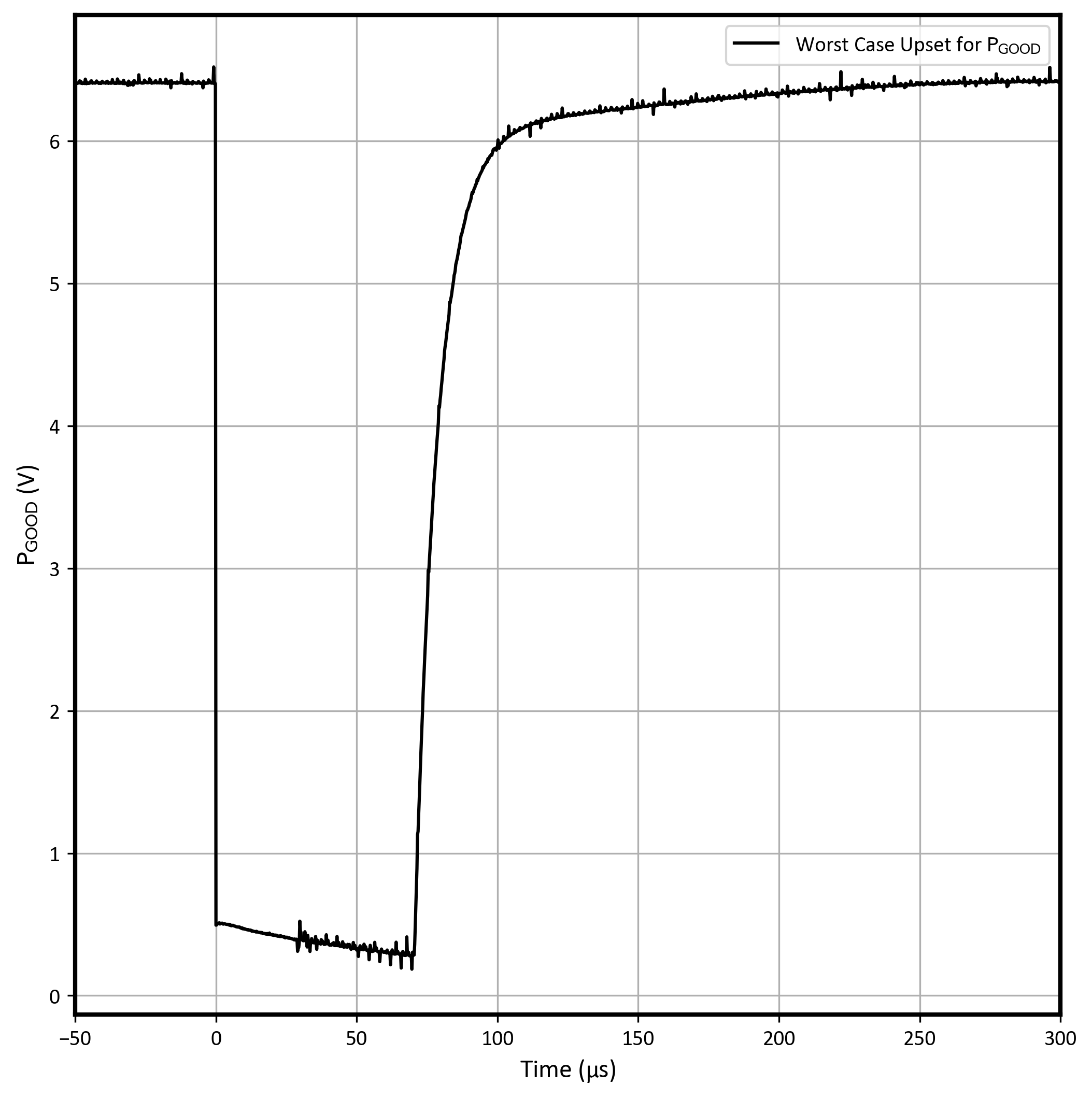SLVK086A january 2022 – may 2023 TPS7H4003-SEP
PRODUCTION DATA
- 1
- Single-Event Effects Test Report of the TPS7H4003-SEP Synchronous Step-Down Converter
- Trademarks
- 1 Introduction
- 2 Single-Event Effects (SEE)
- 3 Device and Test Board Information
- 4 Irradiation Facility and Setup
- 5 Depth, Range, and LETEFF Calculation
- 6 Test Setup and Procedures
- 7 Destructive Single-Event Effects (DSEE)
- 8 Single-Event Transients (SET)
- 9 Event Rate Calculations
- 10Summary
- A Appendix: Total Ionizing Dose From SEE Experiments
- B Appendix: References
- C Revision History
8 Single-Event Transients (SET)
SETs are defined as heavy-ion-induced transients upsets on the VOUT, SS, and the PGOOD flag of the TPS7H4003-SEP. SET testing was performed at room temperature (no external temperature control applied). The species used for the SET testing was a Silver (109Ag) ion with an angle-of-incidence of 0° for an LETEFF = 48.2 MeV·cm2/mg. For more details refer to Section 5. Flux of approximately 105 ions/cm2·s and a fluence of approximately 1 × 107 ions/cm2 were used for the seven SET runs.
VOUT SETs were characterized using a window trigger of ±3% around the nominal output voltage (≈1 V). PGOOD SETs were characterized using a negative edge at VIN – 0.5 V. The output load was set to 18 A for both runs by using Constant Resistance mode on a E36300 Chroma Load. To capture the SETs, two NI-PXIe-5172 scope card and one NI-PXIe-5162 were used to continuously monitor the VOUT, SS, and PGOOD. Each scope was operated independently. The output voltage was monitored using the TP19 and GND test points on the EVM, SS was monitored using the TP5 and GND test points, and PGOOD was monitored using the TP7 and GND test points. The scope triggering from PGOOD also monitored the output voltage.
The scope triggering from VOUT was programmed to record 20k samples with a sample rate of 5 MS/s samples per second (S/s) in case of an event (trigger). The scope triggering from PGOOD was programmed with 30k samples and 5 MS/s. The scope triggering from SS was programmed with 20k samples and 5 MS/s. All three scopes were programmed to record 20% of the data before the trigger happened.
Under heavy-ions, the TPS7H4003-SEP exhibited only a PGOOD transients that reached 0 V. All transients fully recovered in ≤ 300 µs without the need for external intervention.
Test conditions and results are summarized in Table 8-3.
| RUN # | UNIT # | ION | LETEFF (MeV·cm2/mg) | FLUX (ions·cm2/mg) | FLUENCE (# ions) | VIN (V) | VOUTSET (#) ≥ 3% | VOUTSET (#) ≤ –3% | SSSET (#) | PGOODSET
≤ VIN – 0.5 V |
|---|---|---|---|---|---|---|---|---|---|---|
|
12 |
2 | 109Ag | 48.2 | 1.09 × 105 | 9.98 × 106 | 5 | 0 | 0 | 0 | 19 |
13 | 2 | 109Ag | 48.2 | 1.09 × 105 | 9.97 × 106 | 6 | 0 | 0 | 0 | 19 |
|
14 | 3 | 109Ag | 48.2 | 1.09 × 105 | 1 × 107 |
5 | 0 | 0 | 0 | 0 |
Using the MFTF method described in Single-Event Effects (SEE) Confidence Interval Calculations application report, the upper-bound cross-section (using a 95% confidence level) is calculated for the different SETs as shown in Table 8-2.
| SET TYPE | VIN (V) | # UPSETS | UPPER BOUND CROSS SECTION (cm2/device) |
|---|---|---|---|
| VOUTSET ≥ |3%| | 5 | 0 | 1.84 × 10–7 |
| 6 | 0 | 1.85 × 10–7 | |
| PGOOD ≤
VIN (0.5 – V) | 5 | 67 | 4.25 × 10–6 |
| 6 | 59 | 3.81 × 10–6 |
 Figure 8-1 Worst Case PGOODSET ≤ 0.9 V for Run # 13
Figure 8-1 Worst Case PGOODSET ≤ 0.9 V for Run # 13